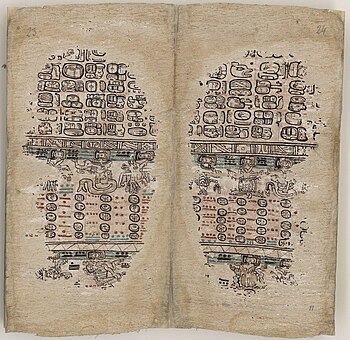Paris Codex
| Paris Codex | |
|---|---|
| Bibliothèque Nationale de France | |

The final two pages of the Paris Codex, showing the Maya "zodiac"
|
|
| Also known as | Codex Peresianus, Codex Pérez |
| Type | codex |
| Date | Postclassic period (c. AD 900-1521) |
| Place of origin | Yucatán, Mexico |
| Language(s) | Maya |
| Material | bark paper |
| Size | 140 by 23.5 centimetres (55.1 by 9.3 in) |
| Format | screenfold book |
| Condition | badly damaged |
| Script | Maya script |
| Contents | ritual almanacs and calendrical information |
| Discovered | 1859 in the Bibliothèque Imperiale |
The Paris Codex (also known as the Codex Peresianus and Codex Pérez) is one of three surviving generally accepted pre-Columbian Maya books dating to the Postclassic Period of Mesoamerican chronology (c. 900–1521 AD). The document is very poorly preserved and has suffered considerable damage to the page edges, resulting in the loss of some of the text. The codex largely relates to a cycle of thirteen 20-year k'atuns and includes details of Maya astronomical signs.
The Paris Codex is generally considered to have been painted in western Yucatán, probably at Mayapan. It has been tentatively dated to around 1450, in the Late Postclassic period (AD 1200–1525). More recently an earlier date of 1185 has been suggested, placing the document in the Early Postclassic (AD 900-1200). However, the astronomical and calendrical information within the codex are consistent with a Classic period cycle from AD 731 to 987 indicating that the codex may be a copy of a much earlier document.
The Paris Codex is currently held at the Bibliothèque Nationale de France in Paris, in the Département des Manuscrits, catalogued as Mexicain 386.
The codex is formed from a strip measuring 140 centimetres (55 in) long by 23.5 centimetres (9.3 in) high, folded into 11 sheets painted on both sides. The Paris Codex is very poorly preserved, comprising a number of fragments; the lime plaster coating of the codex is badly eroded at the edges, resulting in the destruction of its hieroglyphs and images except in the centre of its pages.
The content of the codex is mainly ritual in nature, and one side of the codex contains the patron deities and associated rituals for a cycle of thirteen k'atuns (a 20-year Maya calendrical cycle). One fragment contains animals that represent astronomical signs along the ecliptic including a scorpion and a peccary; fragments of this Maya "zodiac" are depicted on two pages of the codex. Some pages of the codex are marked with annotations made with Latin characters.
On one side of the codex the general format of each page largely follows the same arrangement, with a standing figure on the left hand side and a seated figure on the right hand side. Each page also contains the ajaw day glyph combined with a numerical coefficient, in each case representing a date marking the final day of a calendrical cycle. In spite of the poor state of preservation of the document, enough text has survived to demonstrate that in the case of the Paris Codex, the main series of dates correspond to k'atun-endings, allowing for the reconstruction of some of the lost date glyphs in the text. The seated figures are each associated with a sidereal glyph indicating that they represent the ruling deity of each k'atun.
...
Wikipedia
